
Content
Humanity and the Era of Art
February Event: the future of Learning
March Event: the future of Creativity, Arts & Consciousness
Manifesto: Crisis as catalyst. Risk as renewal
Flowers that generate heat
Club of Amsterdam blog
News about the Future
Recommended Book: Chaos, Creativity, and Cosmic Consciousness
The Letters of Utrecht
Futurist Portrait: Jerome C. Glenn
Welcome to the Club of Amsterdam Journal.
Our February Season Event is about the future of Learning, Thursday, February 27, 18:30 – 21:15.
A collaboration between THNK, the Amsterdam School of Creative Leadership and the Club of Amsterdam
and in March the future of Creativity, Arts & Consciousness, Thursday, March 27, 2014
An event in Amsterdam and Los Angeles!
A collaboration between c3: Center for Conscious Creativity and Vortex Immersion Media in Los Angeles and the Club of Amsterdam.
The event is supported by TPEX (TelePresence EXchange International)
Felix F Bopp, Founder & Chairman
Humanity and the Era of Art
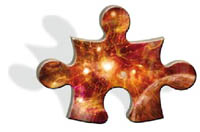

by Rosana Agudo
Keynote address, II International Dreams in Action Unconference:
“Living in the Era of Art”, Bilbao 13-12-13
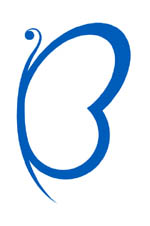 THE BUTTERFLY AS A SYMBOL OF THE II UNCONFERENCE
THE BUTTERFLY AS A SYMBOL OF THE II UNCONFERENCE
“Scientific investigations have shown that the Butterfly is the only living creature capable of changing its genetic structure completely during its process of transformation:
The DNA of the caterpillar that enters the cocoon is different from the Butterfly that emerges from it. Thus, it is the symbol of total transformation.
The Butterfly represents the need for change and increasing liberty as well as courage: we need courage to carry out the changes required by our growth process.
According to ancestral tradition, its medicine is related to air and the power of the mind. It shows us how to find clarity in our mental processes, for organizing projects or discovering the next step in our inner growth, such that: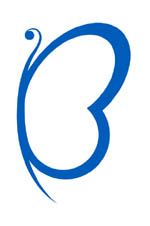
The egg is the beginning, the birth of an idea or project.
The larva is the decision to manifest something in the physical world.
The cocoon represents the need to “go inside”, be it for inner reflection or for the development of a project. And the breaking open of the cocoon signifies sharing with the world the splendor of the new creation.”
“The flutter of a butterfly’s wings
can be felt on the other side of the world.”
It is said of the era we are entering now:
“THIS ISN’T AN ERA OF CHANGE, BUT THE CHANGE OF AN ERA”
But who changes from one era to the next? How is this done? Who or what changes the era? How will we notice it? Why do we say this? What does it mean?
HUMANITY AND THE ERA OF ART
What is humanity? Humanity is a term that refers exclusively to the human sphere, that is, to people. When we refer to humanity in holistic terms, we are only talking about what concerns us, about what concerns the human species.
We tend to forget the existence of other worlds and other creatures that share the planet with us, and that are evolving along with us. On this blessed planet matter evolves, life evolves, the mind evolves and the spirit evolves.
But now let us talk about Humanity. We, humans, men and women, are creatures who are evolving by way of the kind of mind that we call “rational”. We are capable of thinking, and have developed a unique way of communicating, called language, and beyond that, writing.
We are also capable of locating ourselves in time and space; we have developed a system called “history” that lets us place our eternal wanderings in a structure that allows us to situate ourselves and use our organism in a healthy fashion.
In this respect, Ramesh Balsekar tells us: “We need space so that things can unfold. And we need time so that we can perceive, recognize and measure, in terms of duration, the existence of each object and each occurrence”.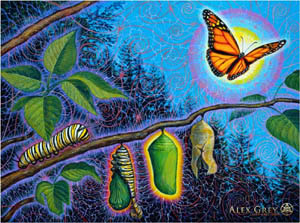
For a very long time now, especially since the era of industrialization, we have been functioning more and more intensely with the dyad
TIME = MONEY.
But for the “next octave”, so to speak, that we are now approaching and that is so much more subtle to us human beings, the dyad is:
TIME = ART.
And now is the moment to understand Art in a new, surprising way and to live it intensely, not by putting our energy into fighting the status quo – that would only retain it and waste it – but rather, by supporting with all our means that which elevates it.
In his novel “Momo”, Michael Ende tells us:
“The more time you have inside you, the older you get.”
Each one of us has the opportunity to decide whether to use the time we accumulate to grow old, or to convert it into art. And this art is not only within the person who creates it or executes it but also in the eyes that contemplate it. To awaken “the eye for beauty” is to convert time into art.
Humanity advances; it evolves as a Totality.
Humanity is a being of interdependent cells. These cells need each other in order to configure the Totality they belong to and to show and to unfold themselves in infinite diversity. At the same time, these cells are inter-INdependent because each one represents, and at the same time, is the Totality to which it belongs. At increasing levels of consciousness these person-cells are becoming more and more aware of themselves and of their surroundings.
The Hindu philosopher, Sri Aurobindo, tells us, “There are three kinds of humans evolving simultaneously on the planet: the human animal, the human, and the human being.” These three types coexist within each one of us. We evolve from one to the other as we grow in consciousness and, of course, in our aspiration for beauty.
To become conscious of ourselves means we realize that we belong to a Totality that embraces us, that exceeds us and that each cell, each one of us, each person, in our heart of hearts, aspires to find and towards which we are nudged along by a fundamental law of evolution: To know we are part of something greater and more all encompassing and to aspire to become one with That.
Sri Aurobindo also tells us: “He or she who aspires to the Infinite, has been chosen by the Infinite.”
Each one of us is, and at the same time forms part of Humanity.
Humanity, in this moment of universal history, is experiencing, in its natural evolutionary process, a phase of maturity towards increasing sensibility and refinement. As does all creation, humanity aspires towards perfection for good and for evil. All humanity aspires towards Beauty, towards Harmony and towards Equilibrium. And as a consequence, all contraries manifest themselves.
Some person-cells feel the impulse and the call of Humanity in various ways and at different levels as a personal aspiration and force. We participate in evolution in diverse fashions and in a myriad of social spheres and in the creation of the surroundings needed by this more refined and subtle creature, that we are and of which we form part. The decisive step forward for Humanity will take place when a critical mass of person-cells acquires this self-awareness and begins to participate voluntarily in the evolutionary process, following the impulse that, at the same time, along the way and by taking action, will make us more and more subtle and increasingly awakened to beauty.
“The value of education is not the learning of many facts but the training of the mind to think.” Albert Einstein (Remember that our species evolves through the mind.)
One of the tasks at hand for education, and not just formal education, is to awaken the eye for beauty. Parents, adults, who are awakened to beauty, transmit the ability to comprehend, observe and enjoy beauty in all its forms to their children.
To learn to learn, to comprehend life and the beauty of the “cosmic plan”, the interaction and fraternity among all life on the planet and with Mother Earth herself, nurturer of our experience and our evolution within her… This, the best legacy we can leave to future generations, will lead evolutionarily to an accelerated improvement of the species. It will lead to the destiny promised to humanity.
The Objective of the Era of Art is to create beauty and harmony, and in the process, generate economy. When Art is seen only as a business, as is now the case in our society, it loses its transformative capability, its power to touch the soul of society.
We observe that because art has the capacity to touch the soul and generate transformation, the economic and financial system with its alienating values that rules society, in an effort to maintain its supremacy at any cost, undermines artistic expression, banishing art, culture, to an underworld where it is reduced to a superfluous hobby, a past time. Artists, for their part, people who care greatly about their work, who cultivate their passion, are made to be seen as rare specimens touched by a special grace that is inaccessible to the rest of us – that is, if they are not labeled as lazy, useless and a burden to society.
In spite of all this, if we resist fighting against the system, we can use our energy to support, with all our strength and capabilities, that which elevates the soul of society, that which permits creativity. We can learn to be amazed by the new, to generate new projects in other directions, with other objectives, for which money is a tool, a means and a consequence of a job well done.
The Era of Art, will bring wealth and prosperity to the world but no longer will money be made at Art’s expense.
In the Era of Art, necessities will no longer be generated as the consumer society has been doing for so long. Instead, we will satisfy insufficiencies. Our attention will be directed at generating a healthier and more intelligent society, rather than one that becomes more and more needy, in the most ample sense of the word. Physical and emotional pain are inherent in the process of self-regeneration of our human condition but poverty, extreme need, and senseless violence are the consequence of the perversion of some of Humanity’s person-cells and these are destined to be cured or will become extinct in a natural fashion when the evolved person-cells take action once having achieved their critical mass.
To live in the Era of Art is, therefore, the experience of learning to create wealth through all the manifestations of action. In this era, wealth is conceived to be a consequence of the aspiration towards harmony and beauty and will generate an economy that, in turn, promotes the genuine expression of each capability for the satisfaction of each of society’s needs. And this is Art.
Returning to the questions posed above: for us the era will change when a certain number of human beings have made a quantum leap in consciousness. We change the era in our aspiration to become one with that which embraces us, with that we form a part of and at the same time are. We change the era when we comprehend the power of the paradox that confronts the opposites, that generates pain and paralyzes the evolution of action. We change the era when we decisively support those aims we believe to be the highest and that will generate the most wealth in realms impoverished by lack of diversity.
Finally, because the aspiration precedes the thought, the thought precedes the idea and the idea precedes the word, the Era of Art is manifesting and this II Unconference is its expression in this physical space with all of you here present and contributing your active and voluntary participation.
Infinite thanks to all of you, Artlivingmakers, pioneers and promoters of the Era of Art.
THE ERA OF ART
AND PERFECTION IN SERVICE
The Club of Amsterdam has been a partner in this conference.
February Event: the future of Learning

the future of Learning
The impact of culture on teaching and early learning.
Thursday, February 27, 2014, 18:30–21:15
Location: THNK, Haarlemmerweg 8a, 1014 BE Amsterdam (Westergasfabriek)
The conference language is English.
A collaboration between THNK, the Amsterdam School of Creative Leadership and the Club of Amsterdam.
Our event will take inspiration and use elements of the THNK Forum format which is designed to deepen dialogue and elevate discussion by asking questions and re-framing issues to lead to surprising insights.
Beyond the lecture model
The traditional way to impart knowledge has been the lecture and question-and-answer session. The message is usually completely fixed before it is communicated. The question-and-answer session allows the audience to get clarification and to put in critical comments. But it is also often unfocused, because questions are dealt with haphazardly as they are raised.
Going out of our comfort zone
Participants ask the questions and structure the dialogue; they share the responsibility for an interesting outcome. It requires commitment and courage. The experts in creative leadership are encouraged to ask questions of the participants, to make it a true dialogue; this means it’s a two-way street, and participants need to abandon the comfortable position of being the only ones asking questions.
Our “thought starters” are:
 Emer Beamer, Social Designer and Educator. Founder at Unexpect, co-founder at Butterfly Works and NairoBits Education’s Blind Spots |
 Huib Wursten, Senior Partner, itim International Can we introduce “best practices” in education across countries? |
March Event: the future of Creativity, Arts & Consciousness

| the future of Creativity, Arts & Consciousness, Thursday, March 27, 2014 Location in Amsterdam: Mediamatic, Van Gendthallen (next to Roest), VOC-kade 10, Amsterdam The conference language is English. A collaboration between c3: Center for Conscious Creativity and Vortex Immersion Media in Los Angeles and the Club of Amsterdam. The event is supported by TPEX (TelePresence EXchange International) For information about the event in Los Angeles, March 27, 9:30am – 12:15 (Los Angeles time), see The Vortex Dome, www.thevortexdome.com Humanity has been creating culture and telling stories since the days of early humans when man applied pigments to the walls of caves and told stories around the campfire. Stories are the river that runs through time and the tools and technologies that we design become the rivulets, streams and whirlpools that give us new ways to express our experiences. The human genius has created such fantastic ways to express and share creativity — from music, dance, poetry, visual art and architecture to the book to the theater, from radio to cinema, television, and now the worldwide web and beyond…we now have the tools and the ability to express our stories and culture on a global level. At the same time we are learning more about the nature of the brain and human consciousness. We are unlocking the mysteries of spiritual traditions and discovering the power of meditation to activate greater awareness and health. We are learning how the arts and media effect us and how we can effect others with our art and stories. Where are we headed? Let’s explore possibilities…. The speakers and topics are Los Angeles Kate McCallum, Founder, c3: Center for Conscious Creativity, Vice President, Vortex Immersion Media, Inc Transmedia, Transformation and the Future of Content Amsterdam Felix B Bopp, Chairman, Club of Amsterdam Travelling in Space and Time – a personal journey Los Angeles Ed Lantz, President and CTO of Vortex Immersion Media, Inc Immersive Media, Art and Consciousness Amsterdam Jack Gallagher, Artistic Director, Bodies Anonymous Vigorous Risk and our moderator in Amsterdam is Paul Hughes, Ten Meters of Thinking Part II Open discussion Amsterdam connects with Los Angeles … a dialogue between the two cities        Exhibition in Amsterdam with Roni Peled, Jelena Popadic, Job Romijn, Robert Shepherd, Winston Nanlohy, … |
Manifesto crisis as catalyst. Risks as renewalold

Manifesto: Crisis as catalyst. Risk as renewal.
by Noah Raford
Classical strategic planning is based upon the assumption of a slowly changing future. That assumption is wrong.
Climate change, technological innovation, resource shortages, political and social volatility, and more frequent technical and natural disasters point to a newly emerging context for strategic planning. The U.S. Army War College calls this the “VUCA Context“ – Volatile, Uncertain, Complex and Ambiguous.
VUCA conditions lead to a shift in how we understand and enact strategic planning. They create a crisis in how we govern and manage organisations across a range of domains. ”[Seeing the world] as a ceaselessly complex and adaptive system… involves changing the role we imagine for ourselves… from architects of a system we can control… to gardeners living in a shifting ecosystem [mostly out of our control].” (Cooper, 2009).
VUCA and its consequences demonstrate that complexity and crisis themselves are the new context for governance and design. This is uncomfortable. Complexity and collapse, volatility and transition – these will be the defining themes of our decade. Adapting to these conditions requires a re-orientation of our strategic goals and a re-evaluation of the methods we use to accomplish them.
This is uncomfortable. Dealing with transition can produce fear, resistance, and anxiety. As a result, many organisations are retreating from the future. Speaking about urban planning, for example, Isserman writes that we have, “lost sight of the future… creating increasingly feeble, myopic, degenerate frameworks that are more likely to react to yesterday’s events than to prepare the way from here to the future.” The effects are habitual blind spots in many modern organisations; making it difficult to discuss or even think about issues of critical change.
Thankfully, there are a range of useful tools for addressing long term planning under uncertainty. These include scenario planning, futures and foresight, role playing, red teaming, collective intelligence, crowdsourcing, and experiential learning to name but a few. The challenge for 21st Century professionals is to successfully apply these tools, and the lessons they produce, in the context of stiff organisational resistance and political fear. Our job should be to facilitate events and environments that help institutions understand and prepare for rapid transformation under conditions of surprising, disruptive change.
To do so, we must take actions that recognize the difficulties and contingencies of our situation, yet offer tangible solutions for moving beyond them. Such actions are inherently creative, uncertain, and emergent. In order to inspire hope, they must be focused on the positive opportunities which such changes provide. Hope is vital because, without such hope, we are doomed to transactional meaningless or, even worse, the cowardly operationalism of “I was just following orders.”
Like gardeners, we must use our tools to cultivate a larger awareness of the patterns of change around us (the seasons) and use our tools to plant seeds of hope in pragmatic, effective ways. Like designers, we must use these seeds to demonstrate new ways of thinking, acting and behaving under radically changing conditions that offer tangible improvement and inspiration.
Our goal is to use our creativity and insight to move beyond paralysis and towards complexity, to seek out uncertainty and change with the same vigour we have traditionally reserved for stability. Transition is the goal, design is the method, strategy is the outcome.
Dr. Noah Raford is a scenario planner, strategist and policy advisor. He works as an advisor to the UAE Prime Minister’s Office, where he provides policy and strategy advice on a range of special projects. Previously he helped design, develop and manage the nation’s first foresight and scenario planning unit.
Before moving to the Gulf, Noah was a strategy consultant with GBN / Monitor, co-founder of the strategy facilitation boutique Sensitive Dynamics, the former North American Director of the design studio/think-tank Space Syntax Limited and the Senior Research Advisor to Prince Charles’ Foundation for the Built Environment. He is currently a Senior Research Fellow at the London School of Economics Complexity Programme, a fellow at the Bartlett School of Architecture, an advisor to the Scenarios Lab at the USC Annenberg School of Communications, and a fellow of the International Futures Forum.
Flowers that generate heat

by Sharon Robinson, Professor, University of Wollongong, Australia
This video introduces the fascinating world of Hot Plants, flowers that generate heat (thermogenesis) to release scents and attract pollinators. We look at three thermogenic plant species, the monocots Philodendron bipinnatifidium and Colocasia esculenta and the eudicot, Nelumbo nucifera. Some plants such as Philodendron and Sacred lotus are also able to regulate their floral temperature, maintaining their flowers at up to 30 °C above air temperatures over several days. Our research team is investigating how plants produce this heat and how they can regulate their temperature so precisely. We are also interested in why the plants produce heat. Is it to release particular scents to attract pollinators, to give a heat reward to the insects or does it also help the plants reproductive development?
Club of Amsterdam blog

Club of Amsterdam blog
http://clubofamsterdam.blogspot.com
The impact of culture on education
by Huib Wursten, Senior Partner, itim International and
Carel Jacobs is senior consultant/trainer for itim in The Netherlands, he is also Certification Agent for the Educational Sector of the Hofstede Centre.
What more demand for meat means for the future
by Christophe Pelletier, The Happy Future Group Consulting Ltd.
Inner peace and generosity
by Elisabet Sahtouris, Holder of the Elisabet Sahtouris Chair in Living Economies, World Business Academy
ICT4D: Top trends for 2014
by Madanmohan Rao
TPP — copyright versus free speech
by Annie Machon, Director, LEAP Europe. Formerly MI5
Long-Term Science and Technology Policy – Russian Priorities for 2030
by Alexander Sokolov, Alexander Chulok, Vladimir Mesropyan
A couple of billion reasons why Africa is a priority for the future
by Christophe Pelletier, The Happy Future Group Consulting Ltd.
The road to nowhere
by Michael Akerib
Demography and Hegemony
by Michael Akerib
Navigating the Transition
by Chris Thomson
Will Green Buildings Help
by Mike Rana, Published Author, Speaker, Software Engineer
Shaping our Future Evolution
by Chris Thomson
News about the Future

CoderDojo is a non profit global movement founded by James Whelton and Bill Liao.
At Dojos, young people between 5 and 17 learn how to code, develop websites, apps, programs, games and more. Dojos are set up, run by and taught at by volunteers. In addition to learning to code, members meet like minded people, show off what they’ve been working on and so on. CoderDojo makes development and learning to code a fun, sociable, kick ass experience. CoderDojo also puts a strong emphasis on open source and free software, and has a strong network of members and volunteers globally. CoderDojo has just one rule: “Above All: Be Cool“, bullying, lying, wasting people’s time and so on is uncool.

Nanodiamond-embedded contact lenses may improve glaucoma treatment
By 2020, nearly 80 million people are expected to have glaucoma, a disorder of the eye that, if left untreated, can damage the optic nerve and eventually lead to blindness.
The disease often causes pressure in the eye due to a buildup of fluid and a breakdown of the tissue that is responsible for regulating fluid drainage. Doctors commonly treat glaucoma using eye drops that can help the eye drain or decrease fluid production.
Unfortunately, patients frequently have a hard time sticking to the dosing schedules prescribed by their doctors, and the medication — when administered through drops — can cause side effects in the eye and other parts of the body.
In what could be a significant step toward improving the management of glaucoma, researchers from the UCLA School of Dentistry have created a drug delivery system that may have less severe side effects than traditional glaucoma medication and improve patients’ ability to comply with their prescribed treatments. The scientists bound together glaucoma-fighting drugs with nanodiamonds and embedded them onto contact lenses. The drugs are released into the eye when they interact with the patient’s tears.
The new technology showed great promise for sustained glaucoma treatment and, as a side benefit, the nanodiamond-drug compound even improved the contact lenses’ durability.
Recommended Book
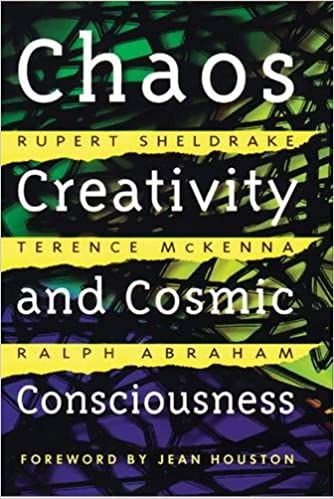
Chaos, Creativity, and Cosmic Consciousness
by Rupert Sheldrake (Author), Terence McKenna (Author), Ralph Abraham (Author), Jean Houston Ph.D. (Foreword)
This book is a vibrant discussion between three of the most original thinkers of our time as they blend science, creativity, intellectual curiosity, and traditional wisdom to explore and expand our current views of reality. The late psychedelic visionary and shamanologist Terence McKenna, acclaimed biologist and originator of the morphogenetic fields theory Rupert Sheldrake, and the mathematician and chaos theory scientist Ralph Abraham join forces to investigate the relationships between chaos and creativity and their connection to cosmic consciousness.
The authors challenge the reader to the deepest levels of thought with wide-ranging investigations of the ecology of inner and outer space, the role of chaos in the dynamics of human creation, and the resacralization of the world. Among the questions the authors raise are: Is Armageddon a self-fulfilling prophecy? Are humans the imaginers or the imagined? Are the eternal laws of nature still evolving? What is the connection between physical light and the light of consciousness?
Part ceremony, part intellectual and spiritual discussion, these trialogues are an invitation to a new understanding of what Jean Houston calls “the dreamscapes of our everyday waking life.”
The Letters of Utrecht
A poem for the future grows in the stones of the street in the center of the town of Utrecht, The Netherlands. One character per stone, one stone per week. Every Saturday a stone mason turns the next stone into the next Letter. In months words appear. With the years verses grow in the streets, extended by a different poet of Utrechts’ guild of poets every few years. Through the centuries the line of the poem will itself draw letters on the map of the changing city.
The poem continues for as long as someone is willing to contribute the next Letter as a gift to his town and its future citizens and link his or her name with a Letter by bearing the costs of its creation.
Explanation of the Letters of Utrecht
At the same time of the publication on the street the Letter appears on this website, with the name of the sponsor. The stone mason can engrave the name or initials of the sponsor in the side of the stone (invisible under the surface of the street).
The Letters of Utrecht were unveiled on June 2, 2012. The beginning of the poem of the Letters of Utrecht was predated to fictitiously start on New Year’s day of the year 2000. The first 648 characters were actually placed on May 30th and 31st, 2012. From June 2d, 2012 onwards the next character is hewn out of the next stone every Saturday.
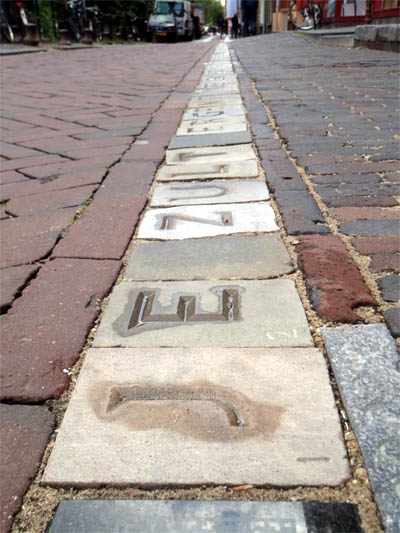
The beginning of the Letters of Utrecht, after some rain.
Futurist Portrait: Jerome C. Glenn
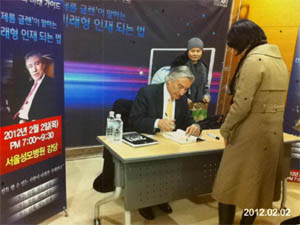
Jerome C. Glenn is the co-founder (1996) and director of The Millennium Project (on global futures research) and co-author with Ted Gordon of the annual State of the Future of the Millennium Project for twelve years.
Quotes
“The world is getting richer, healthier, better educated, more peaceful, and better connected, and people are living longer; yet half the world is potentially unstable.”
“We are winning more than we are losing.”
“Changes in the next 25 years are going to be enormous. We are in a race between implementing greater and greater ways to improve the human condition and tackling an ever-increasing complexity and scale of problems.”
“Pessimism should be stopped. It is a cowardly intellectual position.”
“Maybe the most important thing is not to be looking for the most important thing.”
“By 2025, 1.8 billion people could be living in waterscarce areas desperate enough for mass migrations. We have to create more water, not just pricing policies to redistribute resources. Massive desalinization will be needed as well as seawater agriculture programs along 24,000 kilometers of desert coast lines to produce biofuels, food for humans and animals, and pulp for paper industries – all of which would free up fresh water for other purposes while absorbing CO2.”
“Instead of being pessimistic, we should be realistic and act together as a team. The future of management is not based on a hierarchical structure, but on connecting different lines of action through nodes.”
“How can mystics and technocrats, so long at odds in their vision of the universe, find a common path to the future?
…. Mystics must give up their insistence on the empirical truth of their metaphysics, and technocrats must stop denying the truth of anything that cannot be proven empirically, for both the mystical experience and technology transcend religious and cultural differences.
And it is the transcendent quality of each that will allow them to merge in the ‘conscious technology’ of the future.”
Bio
Jerome C. Glenn is the co-founder (1996) and director of The Millennium Project (on global futures research).
He was the Washington, DC representative for the United Nations University as executive director of the American Council for the UNU 1988-2007.
He has over 35 years of Futures Research experience working for governments, international organizations, and private industry in Science & Technology Policy, Environmental Security, Economics, Education, Defense, Space, Futures Research Methodology, International Telecommunications, and Decision Support Systems with the Committee for the Future, Hudson Institute, Future Options Room, and the Millennium Project. He has addressed or keynoted conferences for over 300 government departments, universities, NGOs, UN organizations, and/or corporations around the world on a variety of future-oriented topics.
Recent research includes: Future Elements of the Next Global Economy, Global Energy Collective Intelligence, National Future Strategy Units, Future Education and Learning Possibilities by 2030, Global Energy Scenarios for 2020, the Future of Ethics, 2025 Science and Technology Scenarios, Middle East Peace Scenarios, and Military R&D Priorities to Reduce Health and Environmental Impacts of Nantotechnolgy.
Glenn was the Deputy Director of Partnership for Productivity International involved in national strategic planning, institutional design, training, and evaluation in economic development in Africa, the Middle East, Asia, the Caribbean, and Latin America and created CARINET in 1983 as the leading computer network in the developing world subsequently bought by CGNet. He has been an independent consultant for the World Bank, UNDP, UNU, UNESCO, FAO, UNEP, US/EPA, USAID, and several governments and corporations.
He invented the “Futures Wheel” a futures assessment technique, Futuristic Curriculum Development, and concepts such as conscious-technology, transinstutions, tele-nations, management by understanding, definition of environmental security, feminine brain drain, just-in-time knowledge and learning, information warfare, feelysis, nodes as a management concept for interconnecting global and local views and actions, and coined the term futuring in 1973. Saturday Review named him among the most unusually gifted leaders of America for his pioneering work in Tropical Medicine (national Leprosy system while a Peace Corp Volunteer), Future-Oriented Education, and Participatory Decision Making Systems in 1974. He was instrumental in naming the first Space Shuttle the Enterprise and banning the first space weapon (FOBS) in SALT II.
He has published over 100 future-oriented articles in such as the Nikkei, ADWEEK, International Tribune, LEADERS, New York Times, McGraw-Hill’s Contemporary Learning Series, Current, Royal Society of Arts (RSA) Journal, Foresight, Futures, Technological Forecasting, Futures Research Quarterly, and The Futurist. He is editor of Futures Research Methodology versions 1.0 and 2.0, author of Future Mind: Merging the Mystical and the Technological in the 21st Century (1989 & 1994), Linking the Future: Findhorn, Auroville, Arcosanti (1979), and co-author of Space Trek: The Endless Migration (1978 & 1979).
Glenn has a BA in philosophy from American University, an MA in Teaching Social Science – Futuristics from Antioch Graduate School of Education (now Antioch University New England), and was a doctoral candidate in general futures research at the University of Massachusetts. He received the Donella Meadows Metal, Kondratieff Metal, Emerald Citation of Excellence, honorary professorship and doctor’s degrees from two universities in South America (Universidad Ricardo Palma and Universidad Franz Tamayo) and is a leading boomerang stunt man.
Global Challenges and the Role of Metropolises
Agenda
Season Events 2013 / 2014 February 27, 2014 the future of Learning The impact of culture on teaching and early learning. Location: THNK, Haarlemmerweg 8a, 1014 BE Amsterdam (Westergasfabriek) A collaboration between THNK, the Amsterdam School of Creative Leadership and the Club of Amsterdam |

March 27, 2014
the future ofCreativity, Arts & Consciousness
Location: Mediamatic, Van Gendthallen (next to Roest), VOC-kade 10, Amsterdam
Co-location: The Vortex Dome, Los Angeles
A collaboration between c3: Center for Conscious Creativity, Vortex Immersion Media, TPEX and the Club of Amsterdam
April 24, 2014
the future of Women in Business
Location: Geelvinck Museum, Keizersgracht 633, 1017 DS Amsterdam
May 29, 2014
the future of Green Architecture
Retrofitting existing houses and historic buildings.
Location: Geelvinck Museum, Keizersgracht 633, 1017 DS Amsterdam
A collaboration between Geelvinck Museum and the Club of Amsterdam
June 26, 2013
the future of Transformation
Special Supporters







Customer Reviews
Thanks for submitting your comment!